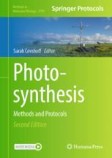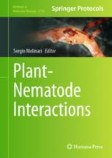Search
Search Results
-
Measurement of O2 Uptake and Evolution in Leaves In Vivo Using Stable Isotopes and Membrane Inlet Mass Spectrometry
Oxygen is both product and substrate of photosynthesis and metabolism in plants, by oxygen evolution through water splitting and uptake by...
-
A Beginner’s Guide to Eddy Covariance: Methodology and Its Applications to Photosynthesis
The eddy covariance technique, commonly applied using flux towers, enables the investigation of greenhouse gas (e.g., carbon dioxide, methane,...
-
A Seedling Growth Inhibition Assay to Measure Phytocytokine Activity
The study of immunomodulatory peptides, both of exogenous and endogenous origin, attracted increasing attention over the last years. Numerous methods...
-
A Trojan Horse Approach Using Ustilago maydis to Study Apoplastic Maize (Zea mays) Peptides In Situ
Plant peptides are important signaling components in many parts of the plant lifecycle, e.g., development, reproduction, environmental stress...
-
Peptide-Mediated Cyclic Nucleotide Signaling in Plants: Identification and Characterization of Interactor Proteins with Nucleotide Cyclase Activity
During the last decades, an increasing number of plant signaling peptides have been discovered and it appears that many of them are specific ligands...
-
Use of PCR-DGGE-Based Molecular Methods to Analyze Nematode Community Diversity
DGGE (denaturing gradient gel electrophoresis) is a nucleic acid separation technique applied to the evaluation of microbial biodiversity. This...
-
Multiplication of Cupressus guadalupensis Using the RITA® Temporary Immersion System
The Guadalupe cypress (Cupressus guadalupensis S. Watson) is an endangered species included in the list of the NOM-059-SEMARNAT-2010. The presence of...
-
Sampling and Extraction of Plant Parasitic Nematodes
The study of nematodes requires availability of nematode specimens and their population densities in plants and soil. This can be achieved using...
-
Multi-omics Resources for Understanding Gene Regulation in Response to ER Stress in Plants
Proteotoxic stress of the endoplasmic reticulum (ER) is a potentially lethal condition that ensues when the biosynthetic capacity of the ER is...
-
Dancing with the Stars: Using Image Analysis to Study the Choreography of the Endoplasmic Reticulum and Its Partners and of Movement Within Its Tubules
In this chapter, approaches to the image analysis of the choreography of the plant endoplasmic reticulum (ER) labeled with fluorescent fusion...
-
Analyzing Photoactivation with Diffusion Models to Study Transport in the Endoplasmic Reticulum Network
Photoactivation is a paradigm consisting in local molecular fluorescent activation by laser illumination in a chosen region (source) while measuring...
-
Characterization of Thermoresponsive Photobody Dynamics
Photobodies (PBs) are subnuclear membraneless organelles that self-assemble via the condensation of the plant photoreceptor and thermosensor...
-
Analysis of Xylem Cells by Nucleus-Based Transcriptomics and Chromatin Profiling
Nuclei contain essential information for cell states, including chromatin and RNA profiles – features which are nowadays accessible using...
-
Feeding Assay to Study the Effect of Phytocytokines on Direct and Indirect Defense in Maize
Phytocytokines mediate defense against pests and pathogens. Many methods have been developed to study the physiological responses triggered by...
-
In-vivo Cross-linking of Biotinylated Peptide Ligands to Cell Surface Receptors
In-vivo cross-linking of biotinylated peptides is a technique to analyze the interaction of small proteins or peptide ligands with their...
-
Rearing and Conservation of Nematode Populations Under Greenhouse or Axenic Conditions
Once a nematode has been identified, to conduct studies for screening programs or pathogenicity tests, it is necessary a supply of large numbers of...
-
Detection of the Effects of Root Exudates (Diffusates) on Nematode Hatching and Attraction
Plant-parasitic nematodes have enormous economic and social impacts. The majority of plant-parasitic nematodes are soil dwelling and feed on plant...
-
Using ER-Targeted Photoconvertible Fluorescent Proteins in Living Plant Cells
Photoconvertible fluorescent proteins (pcFPs) enable differential coloring of a single organelle. Several pcFP-based probes have been targeted to the...
-
Imaging the ER and Endomembrane System in Cereal Endosperm
The cereal endosperm is a complex structure comprising distinct cell types, characterized by specialized organelles for the accumulation of storage...
-
Unfolded Protein Response in Arabidopsis
The unfolded protein response (UPR) is a highly regulated signaling pathway that is largely conserved across eukaryotes. It is essential for cell...
